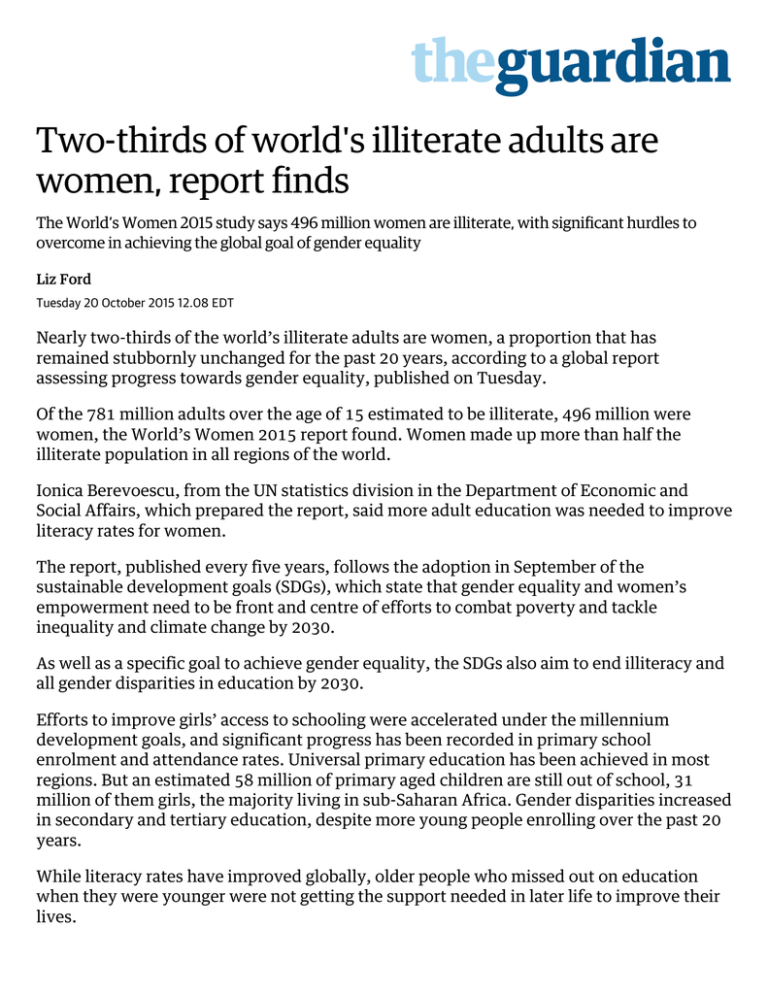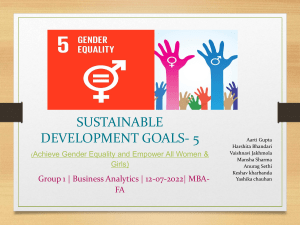Two-thirds of world`s illiterate adults are women, report finds
advertisement

Two-thirds of world's illiterate adults are women, report finds The World’s Women 2015 study says 496 million women are illiterate, with significant hurdles to overcome in achieving the global goal of gender equality Liz Ford Tuesday 20 October 2015 12.08 EDT Nearly two-thirds of the world’s illiterate adults are women, a proportion that has remained stubbornly unchanged for the past 20 years, according to a global report assessing progress towards gender equality, published on Tuesday. Of the 781 million adults over the age of 15 estimated to be illiterate, 496 million were women, the World’s Women 2015 report found. Women made up more than half the illiterate population in all regions of the world. Ionica Berevoescu, from the UN statistics division in the Department of Economic and Social Affairs, which prepared the report, said more adult education was needed to improve literacy rates for women. The report, published every five years, follows the adoption in September of the sustainable development goals (SDGs), which state that gender equality and women’s empowerment need to be front and centre of efforts to combat poverty and tackle inequality and climate change by 2030. As well as a specific goal to achieve gender equality, the SDGs also aim to end illiteracy and all gender disparities in education by 2030. Efforts to improve girls’ access to schooling were accelerated under the millennium development goals, and significant progress has been recorded in primary school enrolment and attendance rates. Universal primary education has been achieved in most regions. But an estimated 58 million of primary aged children are still out of school, 31 million of them girls, the majority living in sub-Saharan Africa. Gender disparities increased in secondary and tertiary education, despite more young people enrolling over the past 20 years. While literacy rates have improved globally, older people who missed out on education when they were younger were not getting the support needed in later life to improve their lives. Over the age of 65, 30% of women and 19% of men were found to be illiterate. Berevoescu said literacy rates among older women and men in Latin America and the Caribbean were similar because a high number of women had access to adult literacy programmes. “For people over 40 or 50, we need to see more in terms of adult education, so once [people] reach older age they are able to enjoy the social and economic opportunities they still have at that time,” she said. Berevoescu was confident that ending illiteracy among under-24-year-olds was possible by 2030, but “for the overall adult population we have to think more in terms of adult programmes in literacy and life-long learning, otherwise [the SDGs] will not be met”. She added that a gender perspective needed to be integrated into all areas, not just literacy or education, and to make sure women are able to participate in programmes. The World’s Women report, launched to mark World Statistics Day, pulled together all the available data related to women and girls. It covers eight key areas – education, health, violence, population and families, work, power and decision-making, environment and poverty. This year’s report found that women were now living longer, marrying later and were less likely to die in childbirth. Birth rates had also fallen, with total fertility rates decreasing from three children to an average of 2.5 between 1990-95 and 2010-15. But the report repeated a common refrain of studies related to women’s rights – significant barriers to achieving gender equality remain. Around one in three women had been the victim of physical or sexual violence – around two-thirds of them faced violence or death at the hands of an intimate partner or family member. The report found that around 60% of all women survivors did not report the crime or seek support. Those who did turned to family or friends rather than police. The report noted that attitudes towards violence against women and girls was beginning to change. In almost all countries with existing data, acceptance of violence against women had decreased over time. Adolescence had proved to be a particularly difficult time for young women and girls, the report found. “Adolescence and young adulthood should be a time of general good health with low mortality rates. Yet in developing regions, complications linked to pregnancy, childbirth, as well as sexually transmitted infections, particularly HIV, continue to take a heavy toll on the lives of adolescent girls and young women,” it said. Underdeveloped health systems, lack of information and decision-making powers put girls at risk of sexually transmitted diseases, pregnancy and unsafe abortion. Boys were also found to take up “risky behaviours” that they believed were associated with masculinity. Road accidents, violence and self-harm were the leading causes of death of young men across the globe. Researchers found that one in three married women in poorer countries had no control over spending on major household purchases, and about one in 10 married women had no say over how the money they earned was spent. Three-quarters of one-parent households were women with children, who were more likely to be poorer than single-parent families with men and child dependents. Berevoescu said the availability of more data meant the UN was better able to monitor violence against women and the quality of education, rather than just enrolment rates. But she added: “It’s very important we make sure that countries have more and more capacity to collect data and to really analyse it from a gender perspective.” More news Topics Universal primary education Sustainable development goals Millennium development goals Gender Literacy Save for later Article saved Reuse this content



